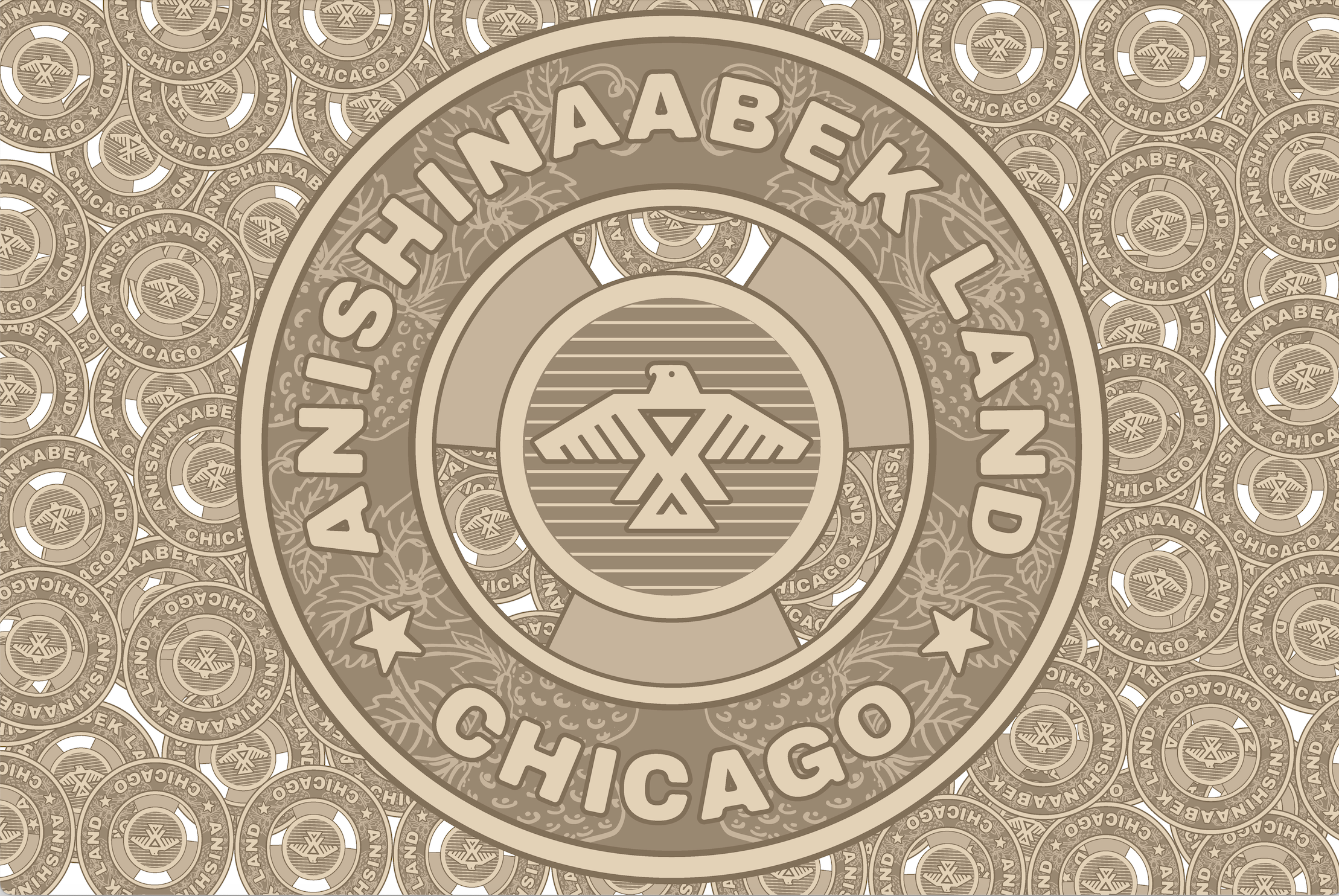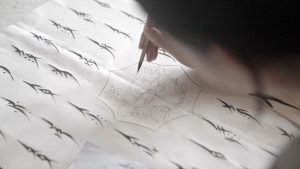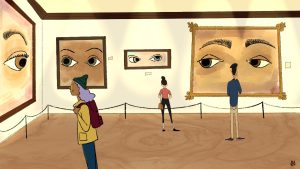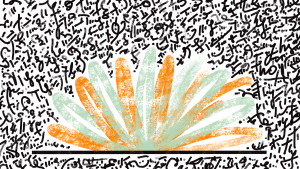Content warning: The following contains descriptions of genocide, slavery, and settler colonial violence.
American history would have you believe that the 1832 Black Hawk War ended the last Native American resistance in the region around Chicago. However, Native peoples are still resisting the violence of settler colonialism built from territorial conquest and chattel slavery.
When Chicago was incorporated in 1837, the calculated and systematic genocide of Native peoples for Western Expansion was well underway with the passage of such policies as the Indian Removal Act of 1830 and the Treaty of Chicago of 1833. The invading U.S. Government used treaties as a means to move west while forcibly removing and displacing Native peoples from their ancestral territories. The goals of American expansionists have always been about securing wealth through the attainment and exploitation of land, which has been romanticized in the American imagination.
Invading Americans constructed their ideologies around being inherently superior to Native peoples. These ideologies are the foundation of Manifest Destiny, defined by John O’Sullivan as the action “to overspread and to possess the whole of the continent which providence has given us for the development of the great experiment of liberty.”1 By adopting this ideology of supremacy, it became Americans’ capitalist and religious mission to colonize the entirety of North America and beyond.
“The cyclone of civilization rolled westward; the forests of untold centuries were swept away; streams dried up; lakes fell back from their ancient bounds; and all our fathers once loved to gaze upon was destroyed, defaced, or marred.”2
Simone Pokagan
In order to further validate the systematic acts of genocide against Native peoples, one of Chicago’s first legislative acts was forming a committee to create an official city seal. In July of 1837, the committee consisting of Mayor Ogden and Aldermen Goodhue and Pearsons presented their draft of the city seal for enactment. The creation of the city seal affirmed the authority of the local government and reinforced the idea of “civilizing” the landscape. The original draft of the city seal no longer exists but the description of its imagery was documented with specificity and used to develop subsequent artistic renderings.
The seal was originally described as “a shield (American) with a sheaf of wheat on its center; a ship in full sail on the right; a sleeping infant on the top; an Indian with bow and arrow on the left; and with the motto ‘Urbs in Horto’ at the bottom of the shield, with the inscription ‘City of Chicago-Incorporated, 4th of March, 1837’ around the outside edge of said seal.”3
If we begin to break down the elements of the city seal, we can examine the racist ideologies of Manifest Destiny and the Doctrine of Discovery. The Doctrine of Discovery was a religious decree that “legitimized” European monarchies’ claims to and colonization of lands outside of Europe. In 1792, U.S. Secretary of State Thomas Jefferson proclaimed that the Doctrine of Discovery as international law was applicable to the U.S. government4. The United States Supreme Court attempted to further legitimize that proclamation in 1823. The case of Johnson v. McIntosh5 passed a landmark decision in which Supreme Court Justice John Marshall used the doctrine to find that the colonial government, not Native tribes, held title to the Indigenous lands.
“The principle of discovery gave European nations an absolute right to New World lands.”
John Marshall
Thus “discovery” of the so-called “New World” entitled European title over these lands and denied the right of occupancy of the Native peoples. Hence, Marshall’s claims upheld the racist ideology that the British government held exclusive rights over Native lands until those rights were passed to that of the United States after the American Revolution while dissolving the sovereignty and self-determination of Native Nations and their peoples.
“Under the ‘doctrine of discovery…’ fee title [ownership] to the lands occupied by Indians when the colonists arrived became vested in the sovereign — first the discovering European nation and later the original states and the United States.”
Oneida Indian Nation of New York, 544 U.S. 197 (2005)
“A shield (American) with a sheaf of wheat on its center” places wheat, a crop introduced to North America by British colonialism which holds biblical symbology as a divine provision for the peoples of God6, in the center of the shield to denote that Chicago will carry out the work of American imperialism as a righteous undertaking. This symbology emphasizes the genocidal acts of colonialism and American imperialism as divinely ordained. Further, the wheat represents lands of plenty and establishes the desire to exploit and extract the Indigenous landscape to meet the agricultural and industrial needs of the growing empire.
“A ship in full sail on the right” is emblematic of the approach of civilization and commerce which erases the established civilization, commerce, and knowledge of Native peoples prior to western interference, as well as erases the contributions of Native peoples and the appropriation of Indigenous knowledge in the development of modern Chicago. The image of a two-masted schooner in full sail arriving at the shore of Chicago symbolizes the inevitable extinction of Native peoples from Chicago as they are replaced by America’s new settler society and fortifies the encroaching European civilization as being right in claiming ownership over Indigenous lands and the extraction and exploitation of their natural resources. The schooner, a cargo ship, is also symbolic of America’s involvement and construction of chattel slavery. Thus, upholding settler moves to innocents in the participation of territorial conquest and chattel slavery. The romanticization of the schooner in full sail represents the “breath of life” in the birth of colonized Chicago. This symbolism superficially reconciles white settler colonial relations to Chicago while denying rematriation of land, power, and privilege to Indigenous and enslaved peoples and their descendants.
“A sleeping infant on the top” symbolizes Chicago as the gem of the Great Lakes. The shell is also a symbol of baptism and the infant represents new birth. Together, they symbolize the cleansing of Chicago and the transfer of lands from the Native population to the invading settler population. Moreover, they symbolize the transfer of land through acts of genocide and other forms of colonial violence as acts of the nation’s youthful innocence.
“An Indian with bow and arrow on the left” is said to represent the original discoverer of the site of Chicago. The assertion of discovery helps the descendants of invading Europeans turned Americans to claim Indigenous lands by asserting modernity through the development of so-called civilization while actively denying the humanity, technology, and governance of Native peoples — thus, constructing our settler colonial state.
America’s justice system has been designed through an imperialist lens and based on the sacerdotal authority of the Doctrine of Discovery and Manifest Destiny. Despite Native presence throughout the history of Chicago, we have become historicized to the brink of extinction in many American imaginations as the rights to Indigenous lands were usurped through acts of genocide by invading Europeans and passed to their descendants under the establishment of the United States.
From 1895 to 1905, “The Indian” held a bow and arrow asserting that the violence that was carried out of these lands was initiated by its Native peoples. The re-characterization of the Indian in 1905 changed the style of clothing from depicting more of a Great Lakes-inspired representation to more of a Plains-inspired portrayal. The bow and arrow are replaced by a tomahawk, which cements the idea of Native peoples being “savages”7 rather than skillful archers. The reimagined Indian reinforces the idea that Native peoples are a mono-culture while erasing the tribally specific characteristics of Native Nations. Additionally, the stereotype of the war-bonneted warrior, made globally popular by the Wild West show, has been written into American history as the last impediment to civilization.8 Thus, once all the “Indians” are gone, Americans become the new Indigenous peoples rather than the white Americans becoming the neo-Indigenous.
“The motto ‘Urbs in Horto’ at the bottom of the shield” means “City in a Garden.” This motto was at the request of William Ogden9, Chicago’s first mayor, who played an integral role in the nation’s transcontinental railroad10. After taking office in 1837, Ogden took out personal loans in order to pay off the city’s debts after the nation had fallen into a span of financial panic due to speculative fever. As the nation fell into a depression, Ogden encouraged Chicagoans to plant their own gardens in the city’s open plots as an investment to their future following the Panic of 183711. Additionally, the motto captured the ambitious plans to commodify Chicago’s hinterlands.
“The inscription ‘City of Chicago-Incorporated, 4th of March, 1837’ around the outside edge of said seal”, marking the year of incorporation, further authenticates the city’s rebirth under western rule. March 4th, 1837 conveys a clear concept that Chicago’s historic heritage begins in 1837, further denying the ancestral connection and history of Native peoples and Chicago’s Indigenous landscape.
”We don’t need any …. seals with sailing ships.“
Mayor Harold Washington
The desire to change Chicago’s city seal isn’t a new call to action. In September 1987, Mayor Harold Washington, along with Alderman Robert Shaw of the 9th ward and Allan Streeter of the 17th ward, condemned the city’s then 150-year-old seal. “You never know what it feels like to be hit by a train until you’re hit by one,” Washington said. ”If peoples find the seal insulting, we should pay attention to them.” Mayor Washington further referred to the seal stating, ”It’s old, it’s degrading and it has historical baggage.” Alderman Shaw proclaimed, “The boat on the seal, according to the framers, was white men coming to America…it gives the appearance of institutionalizing racism.”
Mayor Harold Washington died on November 25th, 1987 and with him the only mayoral support on record to change the city seal. It’s been nearly thirty-five years since the racism within Chicago’s city seal was made public conversation and yet no movement has been made. In 2016, with the help of the Daily Show, Americans witnessed the small village of Whitesboro, New York — with a population of approximately 3,71112 at the time — at the center of a national debate that led to an official changing of their city seal. The seal had depicted a pioneer choking a Native man to death. Over the last five years, this is just one example of municipalities revising their official seals and dismantling public works that celebrate the ongoing colonial violence of chattel slavery and Indigenous genocide in our settler state.
According to Mayor Lightfoot, Chicago is committed to “racial healing and historical reckoning,” but she has yet to make any public statement about the city’s seal. Mayor Lightfoot’s commitment to racial healing was made after the removal of the city’s three Christopher Columbus statues in the summer of 2020 after the Black Indigenous Solidarity rally held on July 17th. During the rally Chicagoans were met by armed police impeding their right to assemble. Additionally, Mayor Lightfoot announced her project to assess the city’s memorials, monuments, and other public art across Chicago. While announcing the formation of her advisory committee, Lightfoot also called for the increase of police presence on the city’s south and west sides, primarily Black communities that have been historically policed as occupied territory.
“There is no way I should have left a protest bruised and battered for exercising my freedom of speech and freedom to assemble.”
Miracle Boyd
Chicago’s police department preceded the city’s incorporation. On January 31, 1835, the state of Illinois authorized the town of Chicago to establish its police force13. By 1851, Chicago had developed a centralized police system to control the “disorder” in the growing metropolis. With the rapid development of Chicago as the keystone location for commerce and economic growth within the United States, “order” was defined by mercantile interests. The Chicago Police Department allowed for the transfer of the cost of protecting mercantile interest and enterprises from the private sector to the state.
Our city’s south and west sides are all too familiar with the military occupation by the Chicago Police Department. From the race riots of 1919 to today, the city of Chicago has used the Police Department to subjugate Black neighborhoods. According to the Police Accountability Task Force, “The linkage between racism and CPD did not just bubble up…Racism and maltreatment at the hands of the police have been consistent complaints from communities of color for decades. And there have been many significant flashpoints over the years — the killing of Fred Hampton (1960s), the Metcalfe hearings (1970s), federal court findings of a pattern and practice of discriminatory hiring (1970s), Jon Burge and his midnight crew (1970s to 1990s), widespread disorderly conduct arrests (1980s), the unconstitutional gang loitering ordinance (1990s), widespread use of investigatory stops and frisks (2000s) and other points. False arrests, coerced confessions and wrongful convictions are also a part of this history. These events and others mark a long, sad history of death, false imprisonment, physical and verbal abuse and general discontent about police actions in neighborhoods of color.”14
The Chicago Monuments Project Advisory Committee has disguised itself as a progressive move by the mayor’s office. Yet if we want to address the history of racism on this Indigenous landscape, we have to start with Chicago’s first acts of legislation, which were made possible by the forced removal and other acts of colonial violence against its Indigenous populations. More concerning in the formation of this committee is the lack of due diligence and accountability when choosing committee members.
Committee member and 38th Ward Alderman, Nicholas Sposato, went on public record calling Black and Indigenous youths “savages” in regards to the Black Indigenous Solidarity rally. In October 2021, Alderman Sposato made headlines by defending Chicago Police Departments after concerns arose about the disparity in traffic stops in neighborhoods that are predominantly Black, including Austin, Garfield Park, and Englewood, compared to the city’s predominantly white neighborhoods. “White people just know how to talk their way out of a ticket. They just cooperate,” said Sposato, whose ward serves a portion of Chicago’s predominantly white northwest side. Sposato, who announced he will be running for re-election back in February, has described himself as “pro-union” on economic issues, but “conservative” on social issues. Sposato has previously admitted that he voted for Trump and is an avid viewer of FOX News. Sposato has also opposed the city council’s resolution re-affirming abortion rights.
Lesser known committee member Heather Miller, former executive director of the American Indian Center and one of the founders of Center for Native Futures, was called out by Chi-Nations Youth Council for commissioning an “All Life Matters” mural that was installed on election day 2020. The “All Life Matters” mural was installed less than two months after Miller called for the American Indian Center to drop out of the Indigenous Peoples’ Day campaign for the City of Chicago, which happened the same month she was publicly appointed to the Monuments and Memorials committee by Mayor Lightfoot. The Mayor had previously appointed Miller to the Cultural Advisory Council for Chicago’s Department of Cultural Affairs and Special Events. However, Miller and former board member of the American Indian Center, Les Begaye, have been working on the Indigenous Peoples’ Day Coalition – Illinois. Their involvement has kept the Chicago Native Community split on supporting this effort that lacks representation of Caribbean community members who were most impacted by the voyages of Columbus. This past Indigenous Peoples’ Day, members of Chicago’s Native community, including individuals of Chi-Nations, disrupted a press conference thrown by Indigenous Peoples’ Day Coalition – Illinois to address the anti-Blackness of the group’s Native leadership.
Additionally, committee member Sergio Giangrande has been extremely vocal in the fight over Columbus’ legacy. In response to changing Columbus Day on the Chicago Public School’s calendar to Indigenous Peoples’ Day in 2020, Giangrande stated, “Italians were once second-class citizens. And it will not be allowed to happen again.” Giangrande’s stance of ensuring Italians do not become “second-class citizens […] again” is directly correlated with Italian Americans’ current proximity to whiteness.
“There has never been since New York was founded so low and ignorant a class among the immigrants who poured in here as the Southern Italians who have been crowding our docks during the past year.”
New York Times March 5, 1882
By 1912, the House Committee on Immigration argued the issue of whether or not Italians could be considered “full-blooded Caucasians”. In the pursuit of whiteness, Italian immigrants latched on to the myth of Columbus as “first founder” of the United States, which served to connect being Catholic and being Italian to the birth of the nation. Italian immigrants adopted the identity of being descendants of the United States’ original founding father. The recognition of Christopher Columbus Day as a federal holiday was essential to Italian-Americans being affirmed as white during the 20th century. The holiday, steeped in white supremacist mythology, has allowed Italian-Americans to write themselves into the founding of America and as champions of the American Dream. The fact remains Italian Americans are legally white and benefit from their whiteness within today’s society. The removal of iconography devoted to Christopher Columbus is not an expulsion of Italian and Italian American contributions within history, but rather an attempt to start unsettling white supremacy and nationalism which now directly benefits Italian Americans.
The inclusion of such committee members and lack of inclusion of Chicago’s city seal makes it clear that this committee was used as a distraction from the lack of accountability in regards to systems of white supremacy and Chicago’s ongoing legacy of police misconduct. As we come closer to elections on February 28th, we have to ask ourselves what part will electoral politics play in the dismantling of white supremacy in Chicago?
* * *
Works Cited:
1. Hietala,Thomas. Manifest Design: American Exceptionalism and Empire. Ithaca, NY: Cornell University Press, 2003.
2. https://collections.carli.illinois.edu/digital/collection/nby_eeayer/id/5642
3. https://chicagocop.com/history/symbols/the-corporate-seal-of-chicago/
4. https://wdfw.wa.gov/sites/default/files/2021-02/workingwithwatribes_0.pdf
5. 21 US 543 (1823)
6. Deuteronomy 32:14, Psalm 81:16, and Psalm 147:14 refer to high quality wheat.
7. https://www.archives.gov/founding-docs/declaration-transcript
8. Linda Scarangella McNenly. “Foe, Friend, or Critic: Native Performers with Buffalo Bill’s Wild West Show and Discourses of Conquest and Friendship in Newspaper Reports.” American Indian Quarterly 38, no. 2 (2014): 143–76. https://doi.org/10.5250/amerindiquar.38.2.0143.
9. https://www.conservationmagazine.org/2014/03/city-garden/
10. http://www.encyclopedia.chicagohistory.org/pages/795.html
11. https://www.library.hbs.edu/hc/crises/1837.html
12. United States Census Bureau
13. https://home.chicagopolice.org/about/history/
14. https://www.americanprogress.org/article/the-problem-with-the-national-response-to-police-racism/
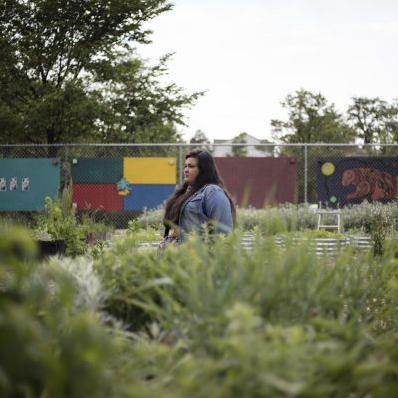
About the author: An advocate for social and environmental justice, Fawn Pochel is the co-founder of the First Nations Garden located in Chicago’s Albany Park neighborhood. Fawn has over a decade of community organizing and advocacy experience focusing on raising awareness of Native Peoples living in Chicago. Fawn has worked closely with communities across the city to incorporate land-based pedagogies and Indigenous worldview into curricula and policy while working towards dismantling systems of white supremacy. Fawn is currently the interim coordinator for Northeastern Illinois University’s Angelina Pedroso Center for Diversity and Intercultural Affairs. In her free time Fawn prides herself on being an Auntie to an autonomous grassroots collaborative, Chi-Nations Youth Council, whose mission is to create safe space for Native Youth through Arts, Activism and Education. Photo by Analú Lopez.
